Your browser does not fully support modern features. Please upgrade for a smoother experience.
Please note this is an old version of this entry, which may differ significantly from the current revision.
Subjects:
Engineering, Aerospace
Unmanned aerial vehicles (UAVs), also referred to as drones, have received momentous attention in various domains of civil and military operations because of their high mobility, enhanced stability, low cost, and high endurance in multiple tasks.
- UAVs
- COVID-19
- technologies
1. Unmanned Aerial Vehicles (UAVs)
Unmanned aerial vehicles (UAVs), also referred to as drones, have received momentous attention in various domains of civil and military operations because of their high mobility, enhanced stability, low cost, and high endurance in multiple tasks. The use cases of UAVs are extensively growing due to the integration of various emerging technologies such as 5G/B5G, artificial intelligence, Internet of Things (IoT), and mobile edge computing. UAVs are being used in a wide variety of applications such as logistics, forest monitoring, construction, freight transportation, communication, healthcare, post-disaster operation, search and rescue, remote sensing, agriculture precision, power-line inspection, traffic surveillance, and object detection and tracking [28,29,30].
In general, UAVs are controlled aerial vehicles which do not carry any human pilot. UAVs can be operated autonomously and remotely through microprocessors, sensors, and other equipment [31]. UAVs make use of communication links to connect with satellites or ground control stations (GCSs) such as smart phones or laptops. To perform remote operation, a human operator is required to control the UAV using a remote control. The use of UAVs is highly encouraged in scenarios where human intervention is strictly limited or hazardous.
Due to the overwhelming interest in drones [32,33,34], several UAVs of varying sizes and forms (shown in Figure 1) have been developed to perform a variety of tasks. The categories of UAVs—single-rotor, multi-rotor, fixed-wing, and hybrid UAVs—have been used in the pandemic and other industrial applications. Each UAV has advantages and disadvantages that help us choose the one that is best suited for the application as shown in Table 2. Different characteristics of these UAVs are also summarized in Table 3.
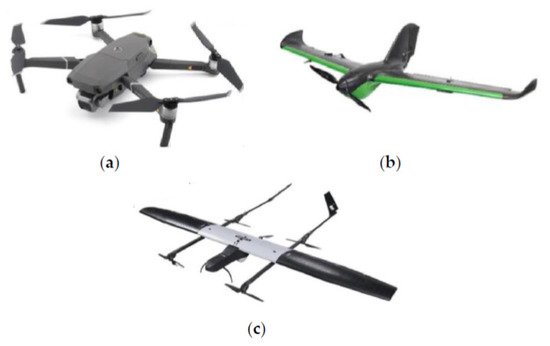
Figure 1. Different types of UAV: (a) rotary wing, (b) fixed wing, (c) fixed-wing hybrid [35].
Table 2. Applications, advantages, and disadvantages of different types of UAVs.
| UAV Type | USD Price | Applications | Advantages | Drawbacks |
|---|---|---|---|---|
| Fixed wing | USD 20,000–150,000 | Structural inspection, area survey | Large area coverage, long endurance, high speed | Launching, landing, high price |
| Rotary wing (helicopter) | USD 20,000–150,000 | Supply drops, inspection | Hovering, large payload | High price |
| Rotary wing (multicopter) | USD 3,000–50,000 | Photography, filmography, inspection | Hovering, availability, low price | Short flight time, small payload |
Table 3. Characteristics of different UAVs.
| Characteristics | Fixed Wing | Rotary Wing | Hybrid |
|---|---|---|---|
| Energy efficiency | High | Low | High |
| Flight system | Complicated | Simple | Complicated |
| Landing | Conventional | Vertical | Vertical |
| Autonomy | No | Yes | Yes |
| Hovering | No | Yes | Yes |
| Power supply | Battery, fuel | Battery | Battery, fuel |
| Endurance | 60–3000 m | 6–180 m | 180–480 m |
| Payload | 1000 kg | 50 kg | 10 kg |
| Weight | 0.1–400,000 kg | 0.01–100 kg | 1.5–65 kg |
2. Applications of UAVs during COVID-19
UAVs have shown great potential in smart cities worldwide. Smart cities have smart healthcare systems based on telemetry, implantable medical equipment, and medical drones to quickly deliver first-aid supplies. UAVs have proven their stature to tackle the COVID-19 pandemic in different countries. However, it is worth noting that the leading organization tackling COVID-19 is the national EMS institution along with several parties such as EMS personnel, nurses, and medical doctors. In addition, several policymakers are considering different preventive measures to fight against COVID-19 including wearing surgical masks, avoiding facial touching, regular handwashing, city lockdown, high-risk area avoidance, social gathering avoidance, and implementing health codes. Policymakers should consider the balance between the economy and public safety before introducing any new measures. Currently, UAVs are being used to perform various tasks (as shown in Figure 2) to prevent COVID-19 such as:
-
Transport of vaccines and medical kits;
-
Public announcements;
-
Crowd surveillance;
-
Spraying disinfection;
-
Mass screening;
-
Crown aerial monitoring;
-
Delivering vaccines and other medical supplies.
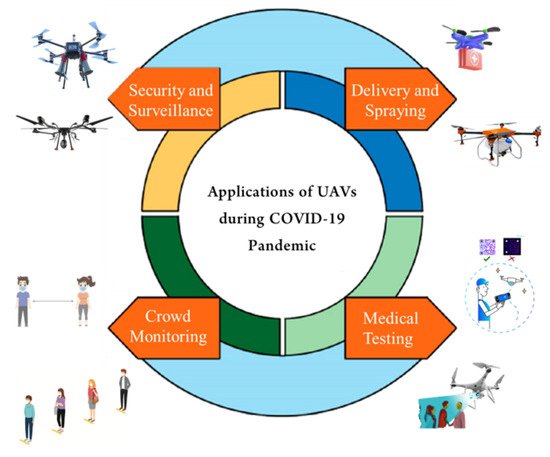
Figure 2. Role of UAVs in COVID-19 pandemic.
2.1. Surveillance and Inspection
The most common usage of drones is for area monitoring or aerial surveillance, both in routine operations and during special operations to battle COVID-19. Area monitoring or aerial surveillance was employed in every country where drone applications were recorded. When visually watching a certain region, several factors must be taken into consideration, including the area’s size, topographical features, spaciousness, built-up ratio, locations of particular importance within the area, the approach points of the area, and the duration of the observation. Point monitoring may be adequate in situations involving smaller or transparent open spaces; in situations involving larger areas, the deployment of many drones arranged in a network is needed; and in situations involving part-time observation, it is essential to patrol with one drone [4]. Drones could even keep an eye on things where there is not much human involvement. The effort and time needed to keep an eye on these places are too great. The invasion of private rights is one of the main obstacles to the drone-based monitoring of individuals. However, by releasing recommendations on public interests, governments are attempting to uphold these rights.
Since 2019, COVID-19 has been mysterious; it has impacted a number of health professionals, including doctors, nurses, cleaning staff, and security personnel. Security staff may monitor unwanted movements and follow activity in hotspot regions without physically visiting them by using drones. They have the ability to take pictures of alleged violators of the occasional preventive instructions provided by governments. There are several benefits to performing this type of surveillance using drones, including avoiding COVID-19 infection among security personnel; saving gasoline and other resources that are often used for physical surveillance; and anytime, anyplace surveillance. Police officers are reluctant to visit hotspots in the absence of drones, but this is a necessary aspect of their job and they must. Since it is the responsibility of the government to protect security personnel from COVID-19, most of them are giving their monitoring departments’ access to drones. In order to include multiple flying ad hoc network (FANET) devices in the COVID-19 task teams, government authorities are modifying their rules. Together with monitoring human mobility [36], security personnel can provide people advice on how to avoid crowding, minimize one-on-one interaction, emphasize the value of social distance, etc. To perform these tasks, the authors of [37] used a drone swarm in a specific area. A camera and sensor were mounted on the ground to capture videos and a real-time view of that area. The medical staff operating through GCS can trace infected people through thermal cameras. Cameras can also monitor social distancing, as shown in Figure 3. Drones can gather information from the GCS and can deliver it to the public through voice or display screens. Table 4 summarizes drone technology used for surveillance tasks in different countries.
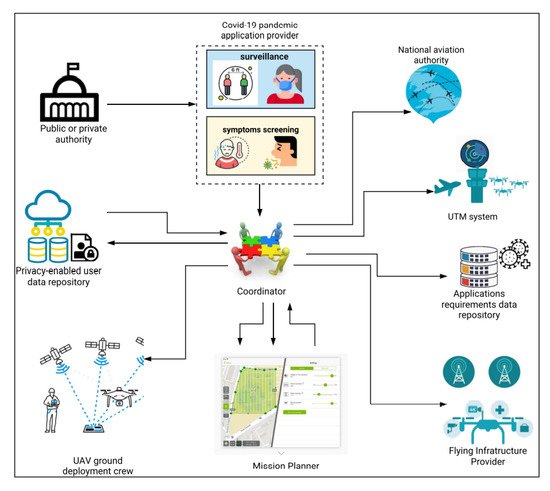
Figure 3. UAV swarm in COVID-19 pandemic [37].
Table 4. Drone technology used for surveillance during the COVID-19 pandemic.
| Reference | Country | Operation |
|---|---|---|
| [38] | Kazakhstan | To patrol and monitor illegal border activities to stop the spread of COVID-19 |
| [39] | France | To patrol over a closed beach to monitor public |
| [40] | Australia | To monitor social distancing at the beach |
| [41] | India | To ensure lockdown implementation by monitoring public |
| [42] | Spain | To monitor streets for anyone ignoring COVID-19 lockdown |
2.2. Broadcasting Messages Using Loudspeaker on Board
In order to spread information, drones equipped with speakers, flags, QR codes, etc., are essential, especially during epidemics. Authorities can use these drones to some extent to deliver crucial messages, particularly in areas where communication links are down. These drones can prove to be one of the most effective communication tools during lockdowns. Municipal corporations can use these drones with sky speakers to reach out to residents in their areas with important messages (such as updates about a lockdown extension, information about which stores are allowed and which are not, health-related communications, implementation of social distancing, and other precautionary guidelines). Due to the fact that most people rely on TV for their communications, especially in rural regions, this sort of communication can break down barriers between municipal corporations and the populace. Figure 4 shows how a UAV with a speaker works to provide alerts to the public and keep individuals safe at home. Drones with speakers are now being used by numerous nations, especially the US, Spain, Britain, and China to communicate with those affected by the COVID-19 epidemic.
The usage of a loudspeaker must consider loudspeaker efficiency and interference, the quality of voice transmission, the pitch and speech segmentation employed, and the space between the flying location of the drone and the individual or group to be briefed. However, entering a public zone belonging to a person is already evidently an issue of flight safety; keeping a minimum safe spacing of 5 m is justifiable. At longer drone-to-human distances, it may be considered that the target’s information receipt is instructive; at relatively short distances, it is a warning, and in the proximity of the open zone, it is already threatening. The action of a drone that maneuvers unexpectedly or dramatically in close proximity and communicates instantly, potentially at an excessive level, may be meant as a warning but may be perceived as menacing.
These speaker-capable drones can aid with crucial communications, alerts during hazardous tasks, or rescue missions in addition to just chatting. Such drones can show themselves to be effective weapons in vast, crowded, and challenging locations while dealing with calamities such as floods, earthquakes, and fires. Despite these benefits, during emergencies and epidemics, they could keep authorities away from close contacts, preventing any likelihood of infection from risky actions and ensuring that the authorities can confidently perform their crucial jobs. Table 5 summarizes drone technology used to broadcast messages in different countries to implement COVID-19 precautionary measures.
Table 5. Drone technology used to broadcast messages for COVID-19.
| Reference | Country | Purpose |
|---|---|---|
| [43] | USA | To broadcast a warning to suspected people to follow social distancing rules |
| [44] | Spain | Police used drones to yell at the public for being outside and ignoring the lockdown |
| [45] | China | Drone mounted with a speaker to inform the public to wear a mask |
| [46] | Malaysia | To give announcements and alerts to the public to curb COVID-19 spread |
| [47] | Hungary | To inform the public to stay at home due to COVID-19 |
| [48] | USA | Anti-COVID-19 volunteer drone to ensure social distancing of 6 feet |
| [49] | Rwanda | To broadcast a crucial message about COVID-19 |

Figure 4. Broadcasting a message by using a loudspeaker [50].
2.3. Broadcasting Messages by Towing QR Code Flag and Illumination
There are various examples of using a drone tow a QR code banner in place of a loudspeaker to facilitate communication. You can use a QR code flag in addition to or rather than a loudspeaker. While QR codes appear to be a “static” version of communication, loudspeakers appear to be a “dynamic” version since they may broadcast “live” messages to the whole public. In the first scenario, the targeted population is being addressed by the drone operator or mission commander who can respond to the situation with brief messages right away in a dynamic environment. In the second scenario, the environment is more or less static and the operator or commander must deliver more complex but standard messages. In the latter scenario, it goes without saying that the targeted demographic will need to utilize their cell phones to obtain the required information online. In many locations, such as crossings, mall parking lots, congested roads, and large-scale sporting events where the border or gate crossing procedure or the staying situation might vary daily, using a QR code can be useful.
On the other side, Chinese authorities are utilizing UAVs to scan drivers entering Shenzhen city by placing overhead QR codes [51]. Figure 5 depicts a motorist who is returning to Shenzhen registering by scanning the QR code. These UAVs were flown close to highway exits or toll booths to encourage approaching vehicles to register so that authorities could follow their movements around the city. However, the drone must be in close proximity, and this application can also cause challenges such as delays and traffic congestion. Additionally, it must be smartly controlled and it should be very close in order to avoid any physical or economic hazards.
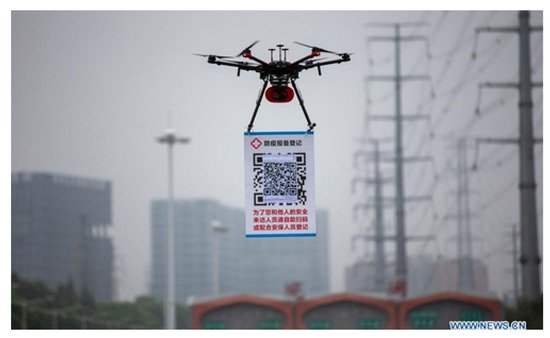
Figure 5. Broadcasting a message through a QR code [51].
In 2020, 300 drones were used to illuminate the sky to honor frontline heroes, medical workers, and patients in the Netherlands [52]. In Seoul, South Korea, hundreds of drones performed a show displaying messages to support the country in the fight against COVID-19. The show started with showing precautionary steps and ended with showing gratitude to medical personnel and the public for their collective efforts against COVID-19, as shown in Figure 6.
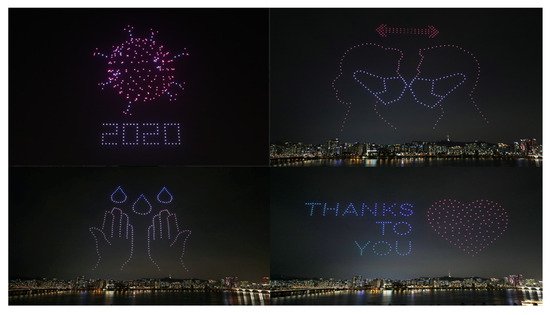
Figure 6. Broadcasting messages through the illumination of drone swarms in South Korea [53].
2.4. Disinfecting Surfaces and Common Areas
As COVID-19 instances increase at an enormous speed, it is clear that most cases are brought on by surface contact with objects found in public spaces, such as chairs, tables, railings, door handles, elevator buttons, public transportation, and shopping centers. Depending on the environmental conditions, the COVID-19 virus can remain present on various surfaces for a few hours to many days. The first step in preventing secondary transmission is to sterilize these surfaces and locations. In general, air disinfection and surface disinfection are the two most popular methods to improve disinfection. In comparison to air decontamination, surface decontamination was more successful in managing the COVID-19 epidemic.
Air disinfections, on the other hand, can offer psychological relief and emotional reassurance that the authorities are making an effort to handle the crisis, and they can also keep rats away. Among the several methods for air sanitization, drone spraying has proven to be beneficial. According to their power and tank capacity, spraying drones often come in several variants. A generalized UAV spraying concept with a small tank is shown in Figure 7. While sanitization employees may be exposed to viral diseases while performing their vital jobs, these UAVs are simple to operate and mobilize and prevent the operator from becoming ill. On the other hand, although having a number of benefits, air disinfection has not been shown to be a reliable way to stop the transmission of viruses. Alcohol-based and other chemicals should not be sprayed excessively on people, cars, or the environment since they are extremely dangerous. Drones can be used to spray disinfectant into public areas when no one is there, such as at the end of the day or on vacations. Sprays based on agriculture should never be used since they are more dangerous than air disinfectants.
Recently, several studies have been reported on employing drones to spray disinfecting solutions against novel coronaviruses [54]. It is important to note further scientific studies that are creating strategies to handle the COVID-19 epidemic more expertly. The study by Kumar et al. [9] focused on interconnected drone-based systems, such as the potential use of drones for disinfectant spraying. In this trial, a 2 km radius was sprayed in 10 min; however, there was no information about the circumstances. Alsamhi et al. [55] provided a framework and suggested a mechanism for employing several drones in decentralized ways. The use of drones to spray disinfectant was also addressed in this study, although no specifics about the practice were provided. In [56], the authors used UAVs to perform disinfection tasks in some areas. They focused on the evaluation of static and dynamic behavior, as well as the impact of spraying flow, mission speed, and flying height. The recommended feasible height was 3 m for good performance. Table 6 summarizes drone technology used to spray disinfectants in some countries against COVID-19.
Table 6. Drone technology used to spray disinfectants for COVID-19.
| Reference | Country | Purpose |
|---|---|---|
| [57] | China | To spray disinfectants to stop the spread of COVID-19 |
| [58] | India | To improve the efficiency and speed of the sterilization operations in public places |
| [59] | Spain | Spain’s military used agriculture drones to spray disinfectants to stop the spread of COVID-19 |
| [60] | USA | Drone to spray disinfectants in large places |
| [61] | UAE | Dubai Municipality conducts a massive sterilization drive against COVID-19 through drones |
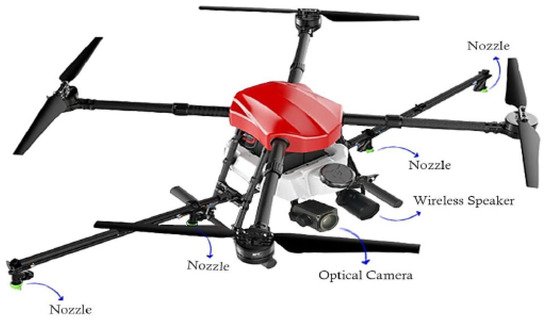
Figure 7. Drone used for spraying disinfectants [62].
2.5. Supporting Medical Services
By using drones, delivery services for food, parcels, medical supplies [63], etc., may become quicker and more sustainable at a lower cost than more conventional delivery methods such as vans and vehicles [64]. Manual delivery may be replaced by the delivery method’s transformation. In order to increase delivery effectiveness and quality of service, using drone control may make it possible to accomplish automatic, unmanned, and information-based distribution. This will close the gap that exists between orders and the capacity for delivery services.
Healthcare professionals would be one of the prominent stakeholders in managing and providing the services to the general public and are at the forefront of modern acceptance of technology. Healthcare professionals have a favorable view regarding the use of drones, according to a study conducted in Oslo, Norway [65]. It is more crucial than ever to transport vaccines to remote regions in a quick, secure way, especially in the COVID-19 age. Drones may be used to deliver COVID-19 vaccines to inaccessible locations, according to several research studies devoted to this topic [66,67]. During the epidemic, a few studies examined customer views concerning drone delivery of general goods or food; these studies, therefore, did not examine public approval of drone delivery in general [68]. Therefore, it is important to investigate how healthcare professionals feel about using drones to deliver medications and vaccines during the COVID-19 pandemic. Malaysia is actively investigating the use of drones to deliver medications and vaccines. Nevertheless, studies on the adoption of drones as a method of delivering vaccines and medications to rural regions by healthcare providers are scarce. In a recent study [69], the authors evaluated the feasibility of drones to deliver medical supplies considering multiple aspects such as payload integration, fleet development, and medical delivery simulations. In [70], the authors used drones for drug distribution considering an optimum way. They focused on finding an optimized trajectory for drones to deliver a drug. They proposed a hybrid model containing K-mean clustering and ant colony algorithms. They compared the performance of different algorithms and stated that the ant colony algorithm yields the closest to optimum results. Drones used to deliver medical and food supplies during COVID-19 are shown in Figure 8. Table 7 summarizes the drone technology for delivery services in different countries.
Massachusetts Institute of Technology (MIT) and UNICEF are working in collaboration to determine the impact of the use of drones to deliver vaccines in remote communities of Nepal [71]. They also analyzed the cost and advantages of drone usage in two districts and developed a set of recommendations. To ensure the complete availability of vaccines, they identified the optimal drone system, delivery hubs, payload, and range, showing a transportation cost saving of USD 0.10–0.12 compared to baseline. The analysis reveals that cost savings can be achieved only when capital costs, including infrastructure cost, delivery start-up, and equipment procurement, are subsidized. This economic analysis shows an intriguing investment case and introduces a sustainable path ahead to integrate drone technology into health supply chains. A Deloitte report and the 2021 World Economic Forum revealed that drone technology can be a cost-efficient option for governments if they have: large-scale deployment, expensive ground transportation, and an affordable drone vendor [72]. Thus, the implementation of drone technology can decrease cost and enhance vaccine availability in a wide range of circumstances and settings if this technology is extensively used to overcome the capital costs of system deployment and maintenance. The major drivers to ensure cost-effectiveness are distance to be traveled, people to be vaccinated, and road speed and cost of conventional ground vehicles [73]. There are several challenges that must be tackled to ensure contactless delivery of healthcare supplies through drones. First, the regulations associated with the usage of this technology are not crystal clear. There are social impacts; e.g., people feel afraid that the extensive applications of this technology can damage the labor market, as the transportation of the products does not need any manpower. Technical issues including the number of products, vendors, payload, and weather conditions have a great impact on the drone delivery industry.
Table 7. Drone technology used for delivery services during the COVID-19 pandemic.
| Reference | Country | Purpose |
|---|---|---|
| [75] | UK | To deliver COVID-19 tests, medicines, and personal protective equipment (PPE) to remote communities in the UK |
| [76] | Ghana | Zipline and UPS are working together to deliver COVID-19 vaccines to health centers in remote areas |
| [77] | USA | A North Carolina health system used UPS Flight Forward drones to deliver COVID-19 vaccines |
| [78] | UK | An NHS drone-based delivery service is used to carry personal protective equipment, blood tests, and COVID-19 samples |
| [79] | Indonesia | A group of drones has been used for contactless delivery of food and medicine |
| [80] | Scotland | UK-based drone specialist Skyports is providing drone service to deliver medical supplies and COVID-19 samples |
| [81] | China | Shanghai firefighters have been using drones to deliver medicines during lockdown |
| [82] | USA | Walmart has started a drone delivery service to collect kits in North Las Vegas and New York |
2.6. COVID-19 Screening and Detection
A person-to-person encounter is one of the most frequent methods of coronavirus infection. Therefore, it is critical to quickly identify both the infected and potentially contaminated parties as a result of the interaction. Massive and quick screening in the surrounding areas is the plan, with little to no human-to-human contact. In this regard, drone technology has changed the game and aided in the mass screening of individuals based on symptoms [83]. These drones have a temperature sensor mounted to keep visitors away from their houses. Additionally, they have a camera for taking images of the subject and a GPS [84] for locating them. An overview of drone technology to find infected and healthy people in the streets can be seen in Figure 9.
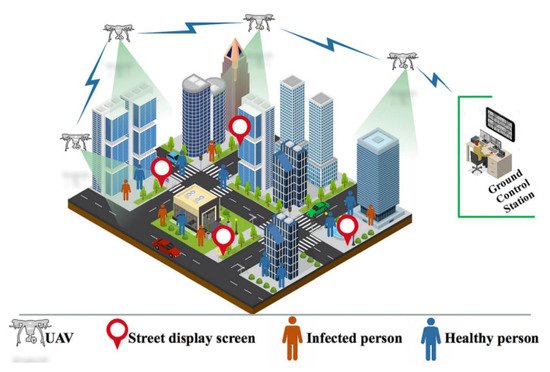
Figure 9. Drone technology used for the detection of infected people [37].
In [1], the authors proposed Covidrone, which uses biomedical sensors to collect medical information from people linked to COVID-19. A sensor module, a disinfection module, testing kits, a wireless communication system, and a DNN model are included in Covidrone’s payload, as shown in Figure 10. Such drones could land in strategically chosen areas and wait for customers who needed their services again. Smart medical sensors on the drone acquire the necessary medical data after authenticating the user and disinfecting the sensing apparatus. Subsequently, a DNN-based model receives these medical data for COVID-19 identification and analysis. Based on the results of his or her test, the user will be advised to take additional medicine or take preventative measures. These test results would be accessible to remote medical workers via cloud services for additional analysis. The elimination of human touch due to process automation aids in the fight against COVID-19. This strategy can give older and physically challenged people access to crucial medical care and testing facilities. Covidrone is expected to help significantly in lowering COVID-19 curves, especially in remote areas where there are not many places to receive medical help. Table 8 summarizes the drone technology for the detection of COVID-19 in different countries.
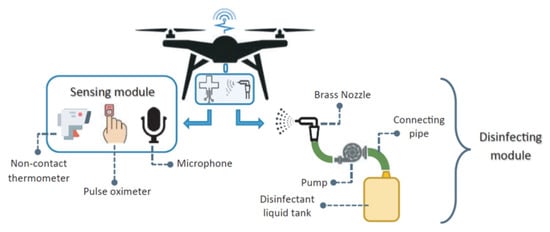
Figure 10. Covidrone schematic for sensing and disinfection [1].
To handle the COVID-19 outbreak, smart healthcare will be developed with the use of detection technologies. Drones, the Internet of Things (IoT), fifth-generation cellular networks, and a DNN model are some of these technologies. Drones have historically been employed in defense-related tasks, such as remotely operating aerial missile launchers. However, in recent years, drones have been utilized for a variety of purposes, including monitoring climate change, taking pictures and videos, and delivering blood. Researchers [85] suggest employing numerous UAV swarms to address various COVID-19 issues, including social isolation, symptom surveillance, and sanitization. For performance and security, they advocate the use of 6G, blockchain, and software-defined networking (SDN). Robots and drones were used by the authors of [9] to monitor COVID-19 hotspots and offer medical assistance where it would be required. Their platform also supports a number of COVID-19 activities, including sanitization, thermal imaging, crowd monitoring, and control. The viability of such systems’ operations is still in doubt because they may need extensive network resources and coordination when implemented in relatively broad locations, such as a village. In a recent study [86], the authors focused on drone-swarm technology to limit the spread of COVID-19. They proposed a system architecture that can identify the infected cases by estimating their biomedical parameters. They considered several techniques such as remote photoplethysmography, thermal measures, and stereoscopic vision to evaluate the target risk. The system can measure the image photoplethysmography signal, skin temperature, and social distancing, which are crucial parameters for tracing infected individuals.
Table 8. Drone technology used for detection during the COVID-19 pandemic.
| Reference | Country | Purpose |
|---|---|---|
| [87] | Australia | The Australian Department of Defense and the University of South Australia are working on drone technology to detect breathing, heartbeat, temperature, and infectious respiratory conditions through sensors and integrated cameras |
| [88] | India | Researchers from the Indian Institute of Technology (IIT) designed an IR-based drone for thermal screening and identifying COVID-19 suspected cases |
| [89] | China | Jiangxi province, China, used drones to check the temperature of people standing on balconies during lockdown |
| [90] | USA | In New York, Dragonfly’s pandemic drone is used to detect COVID-19 infectious conditions including coughing, sneezing, and temperature through integrated sensor and computer vision technologies |
This entry is adapted from the peer-reviewed paper 10.3390/mi13101593
This entry is offline, you can click here to edit this entry!

